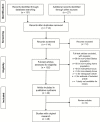Obesity and Nursing Home Care in the United States: A Systematic Review
- PMID: 29253135
- PMCID: PMC6524472
- DOI: 10.1093/geront/gnx128
Obesity and Nursing Home Care in the United States: A Systematic Review
Abstract
Background and objectives: Obesity is increasing among people residing in nursing homes, and resident obesity substantially affects services needed, equipment and facilities provided, and morbidity in this setting. The purpose of this article is to describe the scope and depth of evidence regarding the impact of obesity among nursing home residents in the United States.
Research design and methods: A systematic literature review was performed in PubMed, EMBASE, CINAHL, and Web of Science databases as well as additional hand-searched documents. Included articles were published from 1997 to March 2017. The characteristics and content of the included articles were systematically reviewed and reported.
Results: Twenty-eight studies met inclusion criteria for review. The median study size was 636 residents (interquartile range 40-11,248); 18 (64%) studies were retrospective and 10 (36%) were prospective in nature. Ten (36%) studies examined medical and functional morbidity, 10 (36%) examined health system effects, and 5 (18%) examined the risk of admission to nursing homes. Most studies found that obesity poses serious issues to resident health and the provision of health care, as well as broad health system and nursing challenges in the provision of high-quality nursing home care and services.
Discussion and implications: Although obesity affects about one in four nursing home residents in the United States, relatively limited evidence exists on the complex challenges of obesity for their residents and their care. A continued focus on resident quality of life, health system improvement, and nursing best practices for properly caring for individuals with obesity is needed.
Keywords: Access to and utilization of services; Disparities (health; Healthcare policy; Nursing home; Obesity; racial).
© The Author(s) 2017. Published by Oxford University Press on behalf of The Gerontological Society of America. All rights reserved. For permissions, please e-mail: journals.permissions@oup.com.
References
-
- Allison D. B. Faith M. S. Heo M. & Kotler D. P (1997). Hypothesis concerning the U-shaped relation between body mass index and mortality. American Journal of Epidemiology, 146, 339–349. doi:10.1093/oxfordjournals.aje.a009275 - PubMed
-
- Apelt G. Ellert S. Kuhlmey A. & Garms-Homolová V (2012). [Temporal and structural differences in the care of obese and non-obese people in nursing homes]. Pflege, 25, 271–283. doi:10.1024/1012-5302/a000215 - PubMed
-
- Apelt G., Fabich A., Laurisch E., Paul M., & Garms-Homolová V (2012). [A qualitative study on Nurses’ attitudes towards obese clients in long-term care.]. Pflegewissenschaft, 14, 324–333. doi:10.1111/j.1365-2648.2006.03718.x
-
- Arksey H., & O’Malley L (2005). Scoping studies: Towards a methodological framework. International Journal of Social Research Methodology, 8, 19–32. doi:10.1080/1364557032000119616
Publication types
MeSH terms
Grants and funding
LinkOut - more resources
Full Text Sources
Other Literature Sources
Medical
Miscellaneous


